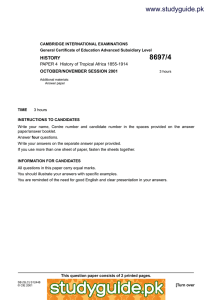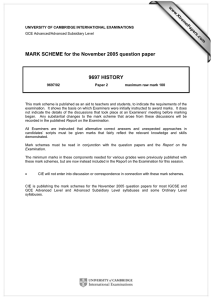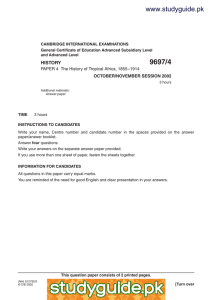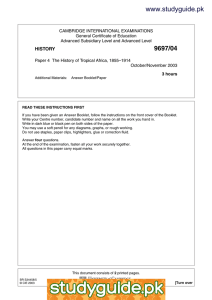www.studyguide.pk MARK SCHEME for the November 2005 question paper 9697 HISTORY
advertisement
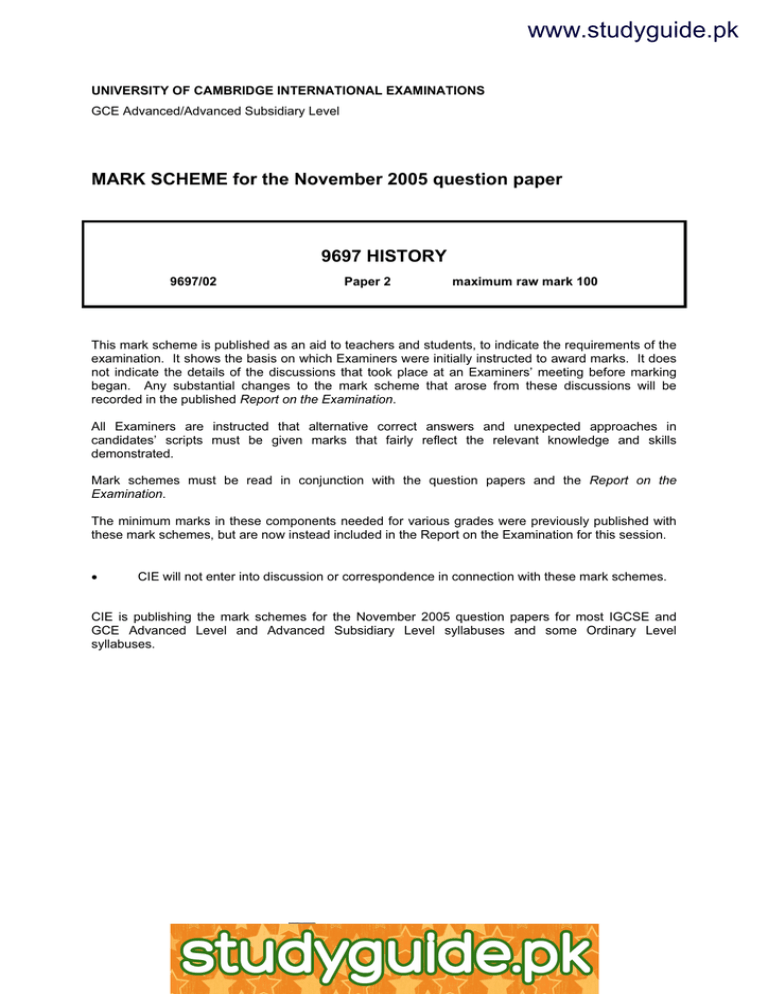
www.studyguide.pk UNIVERSITY OF CAMBRIDGE INTERNATIONAL EXAMINATIONS GCE Advanced/Advanced Subsidiary Level MARK SCHEME for the November 2005 question paper 9697 HISTORY 9697/02 Paper 2 maximum raw mark 100 This mark scheme is published as an aid to teachers and students, to indicate the requirements of the examination. It shows the basis on which Examiners were initially instructed to award marks. It does not indicate the details of the discussions that took place at an Examiners’ meeting before marking began. Any substantial changes to the mark scheme that arose from these discussions will be recorded in the published Report on the Examination. All Examiners are instructed that alternative correct answers and unexpected approaches in candidates’ scripts must be given marks that fairly reflect the relevant knowledge and skills demonstrated. Mark schemes must be read in conjunction with the question papers and the Report on the Examination. The minimum marks in these components needed for various grades were previously published with these mark schemes, but are now instead included in the Report on the Examination for this session. • CIE will not enter into discussion or correspondence in connection with these mark schemes. CIE is publishing the mark schemes for the November 2005 question papers for most IGCSE and GCE Advanced Level and Advanced Subsidiary Level syllabuses and some Ordinary Level syllabuses. www.xtremepapers.net www.studyguide.pk Page 1 Mark Scheme GCE A LEVEL – NOVEMBER 2005 Syllabus 9697 Paper 2 Generic mark bands for essay questions Examiners will assess which Level of Response best reflects most of the answer. An answer will not be required to demonstrate all of the descriptions in a particular Level to qualify for a Mark Band. In bands of 3 marks, Examiners will normally award the middle mark, moderating it up or down according to the particular qualities of the answer. In bands of 2 marks, Examiners should award the lower mark if an answer just deserves the band and the higher mark if the answer clearly deserves the band. Band 1 Marks 21-25 Levels of Response The approach will be consistently analytical or explanatory rather than descriptive or narrative. Essays will be fully relevant. The argument will be structured coherently and supported by very appropriate factual material and ideas. The writing will be accurate. At the lower end of the band, there may be some weaker sections but the overall quality will show that the candidate is in control of the argument. The best answers must be awarded 25 marks. 2 18-20 Essays will be focused clearly on the demands of the question but there will be some unevenness. The approach will be mostly analytical or explanatory rather than descriptive or narrative. The answer will be mostly relevant. Most of the argument will be structured coherently and supported by largely accurate factual material. The impression will be that that a good solid answer has been provided. 3 16-17 Essays will reflect a clear understanding of the question and a fair attempt to provide an argument and factual knowledge to answer it. The approach will contain analysis or explanation but there may be some heavily descriptive or narrative passages. The answer will be largely relevant. Essays will achieve a genuine argument but may lack balance and depth in factual knowledge. Most of the answer will be structured satisfactorily but some parts may lack full coherence. 4 14-15 Essays will indicate attempts to argue relevantly although often implicitly. The approach will depend more on some heavily descriptive or narrative passages than on analysis or explanation, which may be limited to introductions and conclusions. Factual material, sometimes very full, will be used to impart information or describe events rather than to address directly the requirements of the question. The structure of the argument could be more organised more effectively. © University of Cambridge International Examinations 2005 www.xtremepapers.net www.studyguide.pk Page 2 Mark Scheme GCE A LEVEL – NOVEMBER 2005 Syllabus 9697 Paper 2 5 11-13 Essays will offer some appropriate elements but there will be little attempt generally to link factual material to the requirements of the question. The approach will lack analysis and the quality of the description or narrative, although sufficiently accurate and relevant to the topic if not the particular question, will not be linked effectively to the argument. The structure will show weaknesses and the treatment of topics within the answer will be unbalanced. 6 8- 10 Essays will not be properly focused on the requirements of the question. There may be many unsupported assertions and commentaries that lack sufficient factual support. The argument may be of limited relevance to the topic and there may be confusion about the implications of the question. 7 0- 7 Essays will be characterised by significant irrelevance or arguments that do not begin to make significant points. The answers may be largely fragmentary and incoherent. Marks at the bottom of this Band will be given very rarely because even the most wayward and fragmentary answers usually make at least a few valid points. © University of Cambridge International Examinations 2005 www.xtremepapers.net www.studyguide.pk Page 3 Mark Scheme GCE A LEVEL – NOVEMBER 2005 Syllabus 9697 Paper 2 Mark Scheme (Note: generic mark bands will be used in addition to this marking scheme. The generic level descriptors for essays are to be used in conjunction with the question specific mark schemes.) SECTION A Source based question: The 1962 Singapore referendum on the creation of Malaysia. ‘The result of the 1962 Singapore referendum on the creation of Malaysia was a foregone conclusion.’ How far do Sources A-E support this statement? L1. WRITES ABOUT THE HYPOTHESIS, NO VALID USE OF SOURCES [1-5] These answers will be about the creation of Malaysia, and the upper band will discuss the situation in the early 1960s and may suggest why a referendum was held. These answers will ignore the question i.e. they will not use the sources as information/evidence to test the given hypothesis. Include in this level answers which give information taken from the sources, but only producing an account of events rather than exploring the hypothesis. L2. USES INFORMATION TAKEN FROM THE SOURCES TO CHALLENGE OR SUPPORT THE HYPOTHESIS. [6-8] These answers use the sources as information rather than evidence, i.e. sources are used at face value only with no evaluation/interpretation of context. e.g. ‘Yes, source D shows the result of the referendum was expected. Or No, Source E shows that Lee Kuan Yew was relieved at the result so it was not certain.’ L3. USES INFORMATION FROM SOURCES TO CHALLENGE AND SUPPORT THE HYPOTHESIS [9-13] These answers know that testing the hypothesis involves both attempting to confirm or to challenge it. However, sources are still used only at face value. e.g. ‘There is evidence for and against the view that the result of the referendum was a foregone conclusion. Source B describes how the government would not have put forward a referendum which it believed it may lose. On the other hand, source A suggests that in the months approaching the referendum the government thought it may lose, and so had to work hard to secure victory.’ L4. BY INTERPRETING/EVALUATING SOURCES IN CONTEXT, FINDS EVIDENCE TO CHALLENGE OR SUPPORT THE HYPOTHESIS. [14-16] These answers are capable of using sources as evidence, i.e. demonstrating their utility in testing the hypothesis by interpreting them in historical context rather than simply accepting them at face value (as in L3) e.g. 'I don't think the result was a foregone conclusion. Source A indicates that a lot had to be done behind the scenes to secure a victory, and source E indicates Lee’s private relief upon hearing the result. Neither of these last two factors would have been available to the public at the time. As a historian, the author of Source A is able to reflect on these events with hindsight, access sources and documents not available to the public at the time, and approach the question with a historian’s objectivity. Source E shows private emotions, which Lee would have wanted to conceal, from the public at the time so as not to his encourage his opponents.’ © University of Cambridge International Examinations 2005 www.xtremepapers.net www.studyguide.pk Page 4 Mark Scheme GCE A LEVEL – NOVEMBER 2005 Syllabus 9697 Paper 2 L5. BY INTERPRETING/EVALUATING SOURCES IN CONTEXT, FINDS EVIDENCE TO CHALLENGE AND SUPPORT THE HYPOTHESIS. [17-21] These answers know that testing the hypothesis involves attempting both to confirm and challenge the hypothesis, and are capable of using sources as evidence to do this (i.e. both confirmation and challenge are done at this level). e.g. [As L4 but] 'However, some of the sources do suggest that the result was a foregone conclusion. David Marshal’s statement demonstrates how the election was undemocratic, with a lack of choice for the public. However, was Marshall’s statement really about the referendum, or did the issue of referendum serve to illustrate his more general opposition to the government, particularly his belief that it was undemocratic? More importantly perhaps, Lee Kuan Yew would not have made the public statement in the legislature shown in Source B, unless he believed victory to be inevitable, for had he lost, this statement would have come back to haunt him and would have threatened his political position’. L5. AS L5 PLUS EITHER (a) EXPLAINS WHY EVIDENCE TO CHALLENGE/SUPPORT IS BETTER/PREFERRED, OR (b) RECONCILES/EXPLAINS PROBLEMS IN EVIDENCE TO SHOW THAT NEITHER CHALLENGE NOR SUPPORT IS TO BE PREFERRED. [22-25] For (a), this builds upon L4 and L5, but the argument must be that the evidence for challenging/supporting is better/preferred. This must involve a comparative judgement i.e. not just why some evidence is better, but why other evidence is worse. For (b), include all L5 answers whilst using the evidence to present a nuanced response which may modify the hypothesis (rather than simply seeking to support/contradict) in order to improve it. e.g. ‘Although the actual ‘result’ of the election had to be in favour of merger, for there was no other choice on the ballot, too many spoilt ballot papers might have caused serious political embarrassment as it would have highlighted a significant level of internal opposition. As such, Lee tried to come up with a referendum of which the result, the affirmation of merger, was a certainty. However, as source B illustrates, in doing this the real question which the ballot raised became one of support for the government. This explains both the frantic political activity before the election, as well as the Lee’s private relief afterwards. In the end, with a majority of ballots returned rather than spoilt, the government could spin this result both as an affirmation of the merger, as well as a personal political victory, as is illustrated by the contemporary reporting of the referendum in Source D.’ For highest level in both (a) and (b), the conclusion should be based on an overall assessment of the different opinions/perceptions shown in the sources or by establishing different criteria for support/contradiction. © University of Cambridge International Examinations 2005 www.xtremepapers.net www.studyguide.pk Page 5 Mark Scheme GCE A LEVEL – NOVEMBER 2005 Syllabus 9697 Paper 2 SECTION B You must answer three questions from this section. You must support each answer with examples drawn from at least three countries. 2 ‘The development of colonialism in Southeast Asia was largely motivated by economic considerations.’ How far do you think this is true of the period from 1870 to 1914? Knowledge: candidate should show an awareness of the economic factors which drove the development of colonialism in Southeast Asia. Strong candidates will show knowledge of other factors which challenge the hypothesis. Issues: candidates should judge whether or not economic factors were necessary, important, or contingent reasons for the development of colonialism in Southeast Asia. Examples: Dutch rule in East Indies was strong economic imperialism. Dutch imperial regime dominated by Dutch economic interests, which largely precluded moving towards any social theory of colonialism (like the French -below). Dutch not interested in establishing stable political regimes, preferred to use indirect rule which forestalled any political unrest and resultant disruption to economic activity. Although initial economic activity in Burma aimed at agricultural exploitation, especially after the opening of the Suez canal, later, large scale British economic activity in Burma including ownership of Railways, timber, and eventually the exploitation of oil fields. Strong candidates might examine whether political justifications such as the French idea of mission civilisatrice’, were a rhetorical mask to hide purely economic motives. Counter examples: for ‘political’, rather than ‘economic’ motivations, candidate might examine the justifications of Victorian Britain and Republican France. For instance, may represent colonialism in Southeast Asia as a political and strategic competition between great powers in the period of ‘high imperialism’, e.g. `with the growth of ‘Imperial Nationalism’ in Britain. They must compare these motivations with economic benefits of colonialism, looking at patterns of colonies in terms of such factors as the preponderance of raw materials or the opening of trade routes. Strong candidates may argue that increased colonial activity, whatever its direct motivation, was the result of economic transformations within colonial powers, especially industrialisation, which provided the means to pursue a colonial policy. Complex example: From 1898 Americans pursued a policy of liberating the Philippines politically, whilst maintaining strong economic control. However, initial American intervention in the Philippines was the result of events pertaining to the Cuban war, rather than direct economic motivation or political desire to pursue colonial policy. © University of Cambridge International Examinations 2005 www.xtremepapers.net www.studyguide.pk Page 6 3 Mark Scheme GCE A LEVEL – NOVEMBER 2005 Syllabus 9697 Paper 2 Assess the consequences of colonial rule on traditional societies in Southeast Asia from 1870 to 1914. Knowledge: candidates should demonstrate knowledge of the structure of traditional societies in Southeast Asia up to 1870. Candidate should then examine the impact of colonialism in terms of the changes to existing social practices. Issues: to what extent did the colonial powers bring about modernisation/were the colonial powers necessarily a modernising force? Colonial powers were in some cases happy to work within existing traditions (as they saw them) in order to achieve their goals, whereas in other cases they were absolutely resistant to them, leading to the effective abolition of traditional practices. Strong candidates may consider whether in some cases the abolition of traditional practices did not have positive consequences for indigenous populations. Examples: Indirect rule, the one system which actually sought to preserve and operate through traditional structures, only operated in Malay States - indirect rule under the auspices of the Residential system. Even here, local rulers had to operate with the consent of British power. However, CRUCIALLY, this did not extend to matters relating to religion or local customs. Two dominant but opposed French theories on colonial policy. One emphasising the preservation of traditional social customs in the colonies and ruling through partnership between the indigenous peoples and the colonial authorities. The other emphasising the necessity of indigenous ‘assimilation’ into the French model of society - and therefore an end to traditional practices. In practice, French largely exercised policy of assimilation. Loss of cultural heritage in Burma as it is was absorbed into British India. Loss included replacement of traditional authorities, monarch, local headmen, Buddhist monks. Burma and Malaya were also subject to immigration, causing further disruption to traditional social practices. Traditional social practices were sometimes highly negative, such as debt slavery and local warlordism. Although these were ‘lost’, this had a largely positive effect on the indigenous populations. Economic practices: assimilation of Southeast Asia into the world economy as a function of imperialism, resulting in the demise of small-holding. Candidates may also point out that Siam avoided many of the worst problems brought on by imperial powers by undergoing its own modernisation. This meant that traditional governmental and social authority remained largely intact alongside modern developments. 4 ‘Initiatives to promote indigenous participation in colonial regimes were largely counter-productive.’ Discuss this statement with particular reference to the period from 1914 to 1941. Knowledge: candidates should show an awareness of the ways in which colonial powers attempted to involve indigenous peoples in the functions of their regimes. Issues: The key issue in the question involves whether or not these initiatives, which aimed to offset indigenous resentment and unrest, did not produce their opposite, - in some cases rebellion and revolution. © University of Cambridge International Examinations 2005 www.xtremepapers.net www.studyguide.pk Page 7 Mark Scheme GCE A LEVEL – NOVEMBER 2005 Syllabus 9697 Paper 2 Examples: USA in Philippines: Indigenous control but US influence. French in Vietnam: by building an education system and creating elites, the French sow the seeds of a new class of indigenous leader: obvious example, Ho Chi Minh, who studies in Paris and is influenced by ‘western’ idea of Communism. In addition, the focus upon a new elite class tended to diminish wider participation of the peasantry. Dutch East Indies: The failure of the so-called ‘Ethical Policy’ of colonialism in the Dutch territories which sought to reconcile traditional instructions with colonial rule. Dutch colonial division of society into three social types with the indigenous peoples (‘inlanders’) at the base. Under ‘Ethical Policy’, political debate among indigenous peoples allowed, but not overt political activity. When this occurred in the late 1920s, the Dutch switched to a more repressive policy which closed paths to participation thus signalling the failure of Ethical Policy. Establishment of Dutch-language schools for ‘natives’, creating a unified voice, (albeit in Dutch) for the peoples of the East Indies. 5 To what extent did the Second World War change the character of anti-imperial movements in Southeast Asia? (You must not use examples drawn from Singapore to support your answer) Knowledge: Candidates must demonstrate an understanding of the character of antiimperial movements before, during, and immediately after the Second World War, and assimilate those changes in the light of the events of the war. Issues: candidates should test the hypothesis that the Second World War was a key event in ending imperialism. Examples: Relative solidity of the imperial powers in Southeast Asia in the pre-war period. The Japanese occupation - the promise of ‘Asia for the Asians’, and the creation of the ‘Greater East Asia Co-prosperity sphere’, contrasted with the eventual failure of cooperation in some cases. The growth of military and other forms of resistance by Malayan Chinese and the Vietminh. The granting of independence to some states such as Burma. The declarations of independence in the immediate aftermath of the war e.g. Indonesia. Anti-colonialism of US as key power in region and of UN as world body in post-war period. The reluctance of the colonial powers to relinquish claims to colonial territories e.g. France and Netherlands. Strong candidates will question whether the events of the war and the tensions of the postwar world did not harden the conflict, with colonial powers seeking to re-establish regimes and therefore prestige, against better organised and more violent independence movements. © University of Cambridge International Examinations 2005 www.xtremepapers.net www.studyguide.pk Page 8 6 Mark Scheme GCE A LEVEL – NOVEMBER 2005 Syllabus 9697 Paper 2 ‘The development of Nationalism in Southeast Asia was characterised by the common opposition to colonial rule rather than a collective sense of nationhood.’ How far do you agree with this statement? Knowledge: Candidates should demonstrate some understanding of the term ‘nationalism’ in the context of Southeast Asia. Issues: whether nationalism and nationalist parties were only the result of rebellion against colonial powers or whether their development emerged as a result of a growing sense of collective identity among colonial peoples. Candidates should examine the beliefs upon which Nationalism was founded, e.g. anti-colonialism, religion, ethnicity etc. They should examine the forces for the building of collective identity, such as the modern infrastructure of colonialism, education, or collective oppression, and those which act against collective identity, such as a radical cultural and economic distinction between peasant villages and colonial cities or between different political, ethnic or religious groups. Strong candidates will note how much ‘nationalism’ and nationalist parties endured in the postcolonial period once the common enemy (i.e. the colonial power) had been beaten. Key examples: Vietnam: nationalism joins with communism to fight colonial power. between urban and rural areas creating division rather than unity. Strong distinction Indonesia: Pre-independence, Sukarno argues for unity of the goals of Islamic, Marxist, and nationalist causes towards the goal of independence- with Islam and Marxism subordinate to nationalist goals. Slowly, in the postcolonial period tensions between these three become the driving force of division and conflict in Indonesian politics Malaya: Islam has been used to preserve a sense of ethnic identity against the backdrop of large-scale immigration from China and India. No union of ‘nationalism’ (whether Islamic or otherwise) with communism. Philippines: democratic institutions put in place by the Americans with a view to Philippine independence offset anti -colonial ‘nationalism’, whilst creating the basis of a sense of nationhood under the democratic process. Burma: ravaged by ethnic conflict in post independence period demonstrating an absence of nationhood. © University of Cambridge International Examinations 2005 www.xtremepapers.net www.studyguide.pk Page 9 7 Mark Scheme GCE A LEVEL – NOVEMBER 2005 Syllabus 9697 Paper 2 Examine the factors which allowed the rise of military regimes in Southeast Asian states after independence. Knowledge: candidates should demonstrate knowledge of the role played by the military in newly independent states. Candidates will illustrate examples of where and to what effect the military has intervened in the political process in Southeast Asia. Strong candidates will demonstrate, where appropriate, knowledge of the social make-up of the militaries of Southeast Asia, and how this affected their political outlook. Issues: The central issue is the role of the armed forces in the newly independent states. Have the armed forces been a force for state building? Alternatively, have they destabilised undermined the political process? Strong candidates may consider what effect various paramilitary organisations have had on the stability of states. Examples: Strong military in politics– Indonesia: army as a force which guarantees unity through suppression of rivals. Philippines: between martial law and democracy. Burma: military coup and establishment of one party state. Stronger candidates may consider the following more complex examples: Cambodia-General Lon Nol wins power via the ballet box in 1966. Khmer Rouge and Viet Cong - were these ‘military’ or ‘paramilitary’ organisations? 8 To what extent were the economies of the newly-independent states of Southeast Asia still dominated by foreign economic interests? Knowledge: candidates should demonstrate knowledge of the economic situation of newlyindependent states. They should demonstrate how much internal economic policy was driven by external powers, and the means by which this occurred. Issues: The effect of the Cold War upon independence, especially the economic intervention of the USA and the Soviet Union in Southeast Asia in the post-colonial period. Strong candidates may seek to explore the nature of independence. They may argue that one form of imperialism was replaced by another. They may analyse how much foreign aid for regimes destabilised/or stabilised the region. Examples: The context of the Cold War. USA provided economic aid to non-communist states in Southeast Asia. In response, Soviet Union provided economic aid to both communist and non-communist states. In the creation of Malaysia, Britain promised financial aid in order to maintain political influence. Richer areas, such as Brunei and Singapore, contributed high levels of public money towards poorer areas of the federation such as Borneo. The newly created ‘Malaysian Common Market’ did allow for some regional economic autonomy within the federation. © University of Cambridge International Examinations 2005 www.xtremepapers.net www.studyguide.pk Page 10 Mark Scheme GCE A LEVEL – NOVEMBER 2005 Syllabus 9697 Paper 2 Japan’s attempts to reassert power in the region through ‘quiet’ economic diplomacy in the policy of ‘Official Development Assistance’. In the wake of overt cold war conflict in Asia (i.e. after the fall of Saigon in 1975), Japan forged ‘non-ideological’ economic relations with states such as Vietnam. Thailand received large amounts of foreign aid when its bases were used by the Americans during the Vietnam War thus reinforcing the dominance of political elites. Upon American de-escalation of the conflict and the threat of less economic assistance, the ruling elite were forced to explore democratisation, as well as a wider Asian economic interdependence by developing relations with China and even North Vietnam (before 1975). © University of Cambridge International Examinations 2005 www.xtremepapers.net
